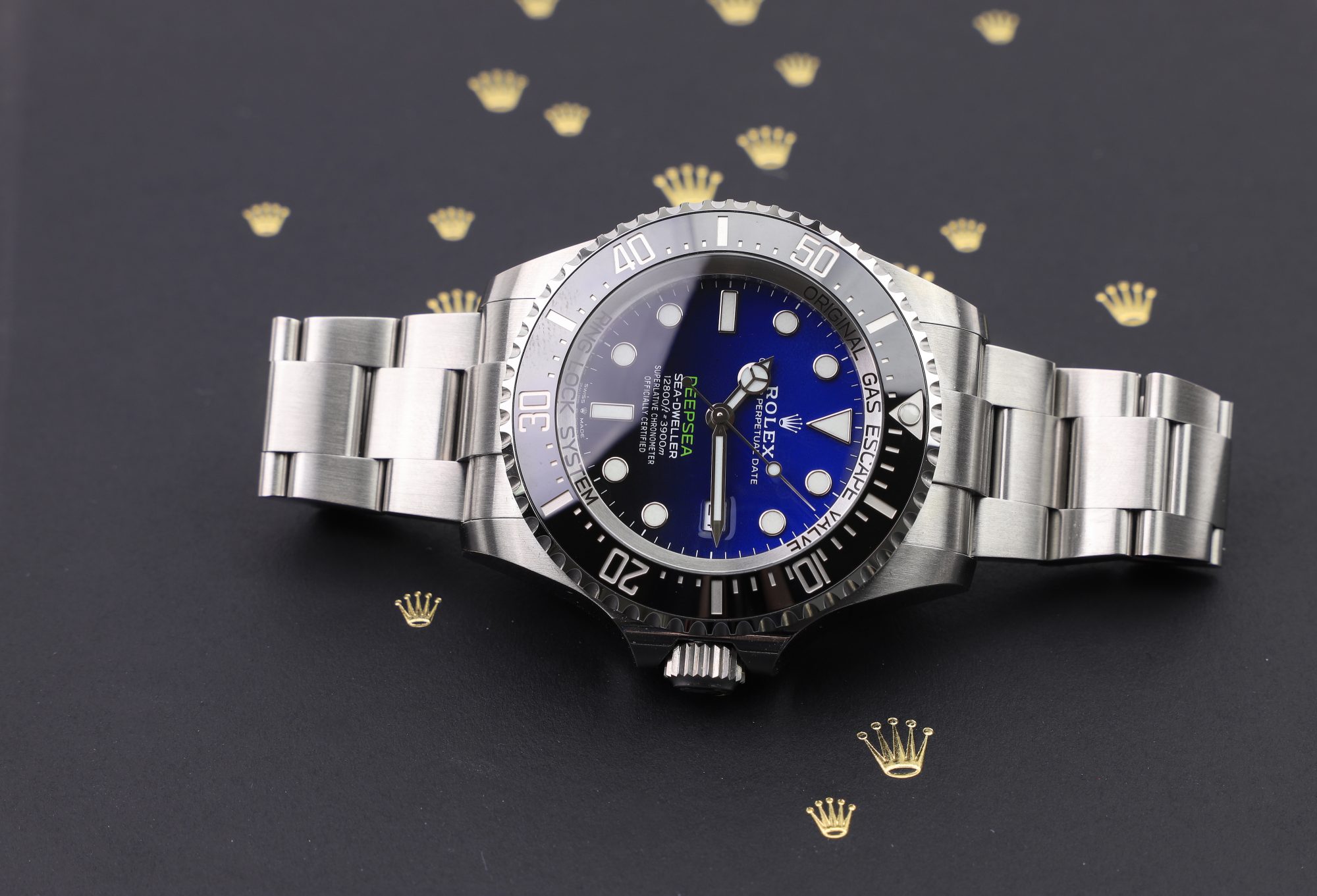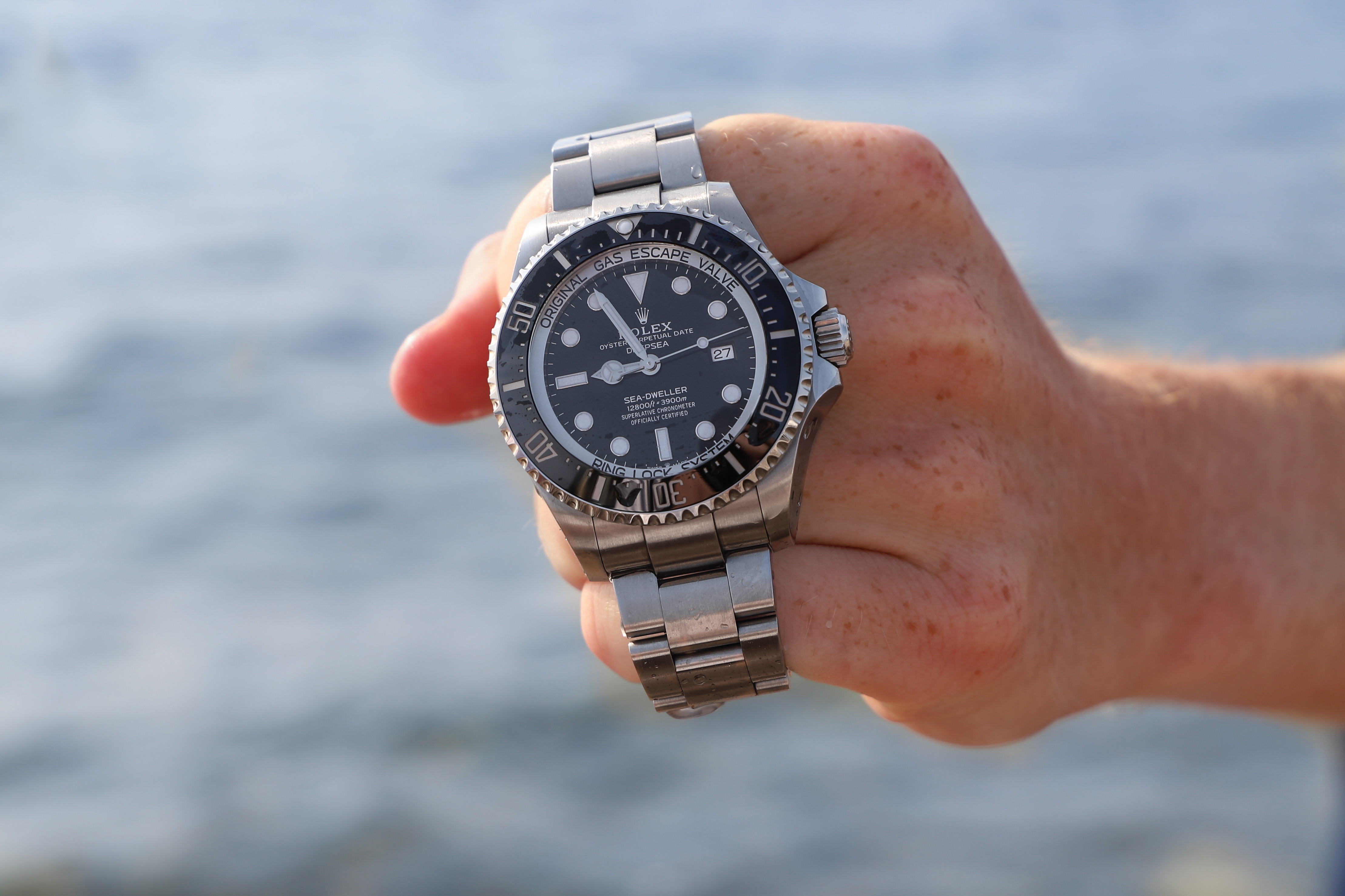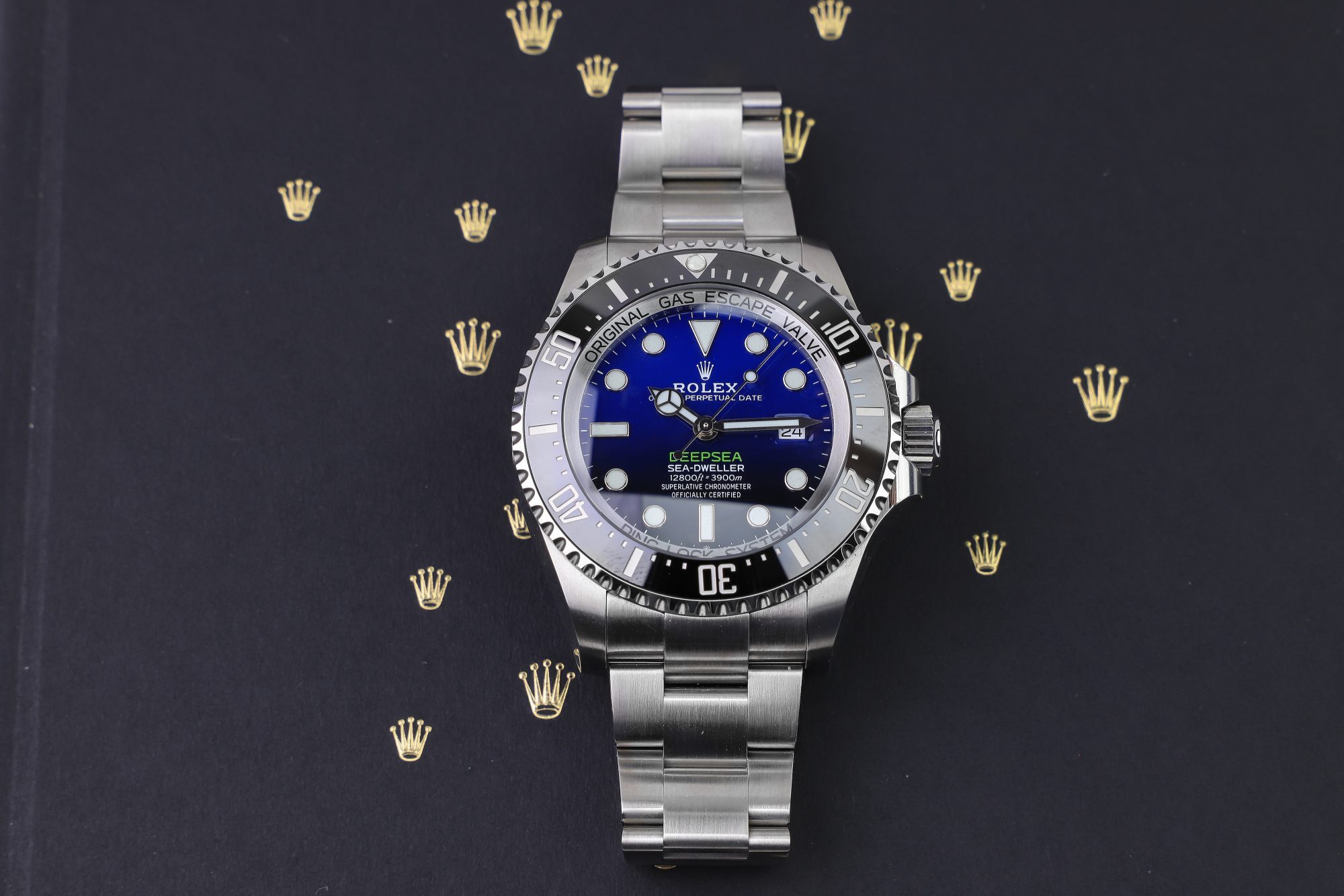
Top 15 Facts About Rolex Sea-Dweller & Deepsea – Interesting Things to Know
The Sea-Dweller is not Rolex’s most popular or well-known model. But it is in fact Rolex’s most durable and robust model. The Sea-Dweller technically consists of two types of watches today. First, we have the Sea-Dweller, and then we have the Deepsea Sea-Dweller. Whilst many think that they are two different models, they are not. The Deepsea is a part of the Sea-Dweller family.
The history of the Sea-Dweller begins in the 1960s when professional divers began diving at great depths. In the 1950s, professional diving became more and more common, and the Submariner was created. But as divers started to dive deeper, they needed watches that would withstand even greater pressure with greater depth ratings.
Rolex took upon itself this challenge and developed the Sea-Dweller. The first Sea-Dweller model was created in the second quarter of 1967 but it wasn’t available to the general public until 1971. Bear in mind that at this time, watches were mostly used for the purposes for which they were built. Today, most people who own a submariner are of course not professional divers. But in the early years of the Sea-Dweller, it was reserved for professional divers.
A distinct feature of the Sea-Dweller is the helium escape valve, which Rolex developed specifically for this model. The purpose of this was to enable even greater resistance against deep depths, which wouldn’t be possible without a way to release the helium that is built up. Interestingly, the very first Sea-Dweller models made between April and June 1967 did not have helium escape valves. We’ll go more into detail about how the helium escape valve came about and much more about the Rolex Sea-Dweller and Deepsea in this article.
In this article, we take a closer look at the top most interesting facts about the Rolex Sea-Dweller and the Deepsea.
Top interesting facts about Rolex Sea-Dweller and Deepsea
1. The helium escape valve was developed by Rolex specifically for the Sea-Dweller
Rolex developed the helium escape valve specifically for the Sea-Dweller. However, as discussed earlier, the very first examples of the Sea-Dwellers from 1967 did not have them. As a matter of fact, the idea of the helium escape valve wasn’t even the idea of Rolex.
It was actually an archeological diver by the name of T. Walker Lloyd who approached Rolex with the idea for the valve. The reason was that divers experienced issues in saturation diving during decompression. The purpose of the helium escape valve is to allow decompression to prevent the watch from being damaged by the pressure change. Today, the helium escape valve is one of the most distinctive features of the Sea-Dwellers and a crucial element that enables great water resistance.
From a technical standpoint, the helium escape valve allows the helium that is trapped inside the watch during decompressing to be released at a given pressure during decompression whilst still preserving the water resistance of the watch. During decompression, the pressure inside the chamber case can decrease quicker than the pressure inside the case. This may, in the worst case, lead to the crystal popping off. The helium escape valve, therefore, solves this issue.

2. Rolex did not develop the Sea-Dweller together with COMEX
Unlike what many people think, Rolex did not develop the Sea-Dweller together with COMEX. COMEX S.A., in French Compagnie Maritime d’Expertises is a French company that specializes in engineering and deep diving operations. The company was founded in November 1961. Whilst COMEX is closely associated with the Sea-Dweller and had a close cooperation with Rolex, they were not a part in the creation of the model.
The fact is that COMEX only became a partner to Rolex in late 1971, several years after the Sea-Dweller was released. However, in the following years, Comex worked closely together with Rolex to carry out experiments and tests to improve the Sea-Dweller and the helium escape valve.
3. The early Sea-Dweller models were only produced in low numbers
As mentioned, the early Sea-Dwellers were made for professionals and not intended for the public. As such, the total production number of these watches remained low. As a matter of fact, of the first models from 1967, the production is estimated to just over 100 watches.
4. The Rolex Deepsea is part of the Sea-Dweller collection
As discussed earlier, both the Sea-Dweller and DeepSea Sea-Dweller are part of the same collection. A lot of people believe that they are two completely different models but this is not the case. The Deepsea was released long after the Sea-Dweller and is essentially just a beefier, upgraded version of the Sea-Dweller.

5. The shortest-produced reference was the Sea-Dweller 116600
As with so many other Rolex models, the Sea-Dweller has had a large number of references throughout the year. Since Rolex is all about evolution, not revolution, Rolex has continuously upgraded and refined its models. As such, there have been many different Sea-Dweller references over the years.
The reference with the shortest production is the Sea-Dweller 40mm reference 116600, also known as Sea-Dweller 4000 in 40mm. This Sea-Dweller had the exact same case as the Submariner at the time with the only difference being that the case was thicker to ensure a greater water-resistance (up to 1220m). Moreover, it naturally also had the helium escape valve, unlike the Submariner.
The 116600 was released in 2014 and discontinued in 2017. Whilst it was in production for a few years, it is a very short production period for a Rolex model, that normally tends to be in production for about 10 years before being discontinued.
6. The Sea-Dweller 43 126000 was released to celebrate the 50th anniversary of the Sea-Dweller
To celebrate the 50th anniversary of the Sea-Dweller model, Rolex launched the Sea-Dweller 43 reference 126600. This reference was launched at Baselworld 2017 and the model is today known as the 50th anniversary Sea-Dweller.
This model replaced the previous reference 116600, also known as the Sea-Dweller 4000 which, as discussed earlier, was the shortest-produced Sea-Dweller model. The watch features a red line of text as a nod to the early Sea-Dweller models.

7. Rolex broke a record in 1960 with a prototype Sea-Dweller
Rolex has broken several records with the Sea-Dweller but a notable one is in 1960 when U.S. Navy Lieutenant Don Walsh and Swiss oceanographer Jacques Piccard reached the world’s deepest point using the bathyscaphe Trieste in the Mariana Trench in the Pacific Ocean. The dive reached a record-breaking depth of 10916 meters/37,800 feet. Most notably for Rolex, mounted on the outside of the submersible was an experimental Rolex watch, known as the Deep Sea Special.
After the dive, the watch was in perfect working order and thereby became a record-breaking watch, going deeper down than any watch had ever gone before. This achievement was of course extremely important for Rolex in establishing a strong and prestigious reputation within the world of diving.
8. Rolex released the first two-tone Sea-Dweller in 2019
The first official Rolex Sea-Dweller in two-tone (gold and steel) was the Sea-Dweller 43 reference 126603 launched in 2019. Prior to this, all Sea-Dwellers were exclusively made in stainless steel.
However, that is not quite the whole story. And technically, you could argue that this wasn’t the first two-tone Sea-Dweller. In the 1960s, Rolex created a few Deep Sea Special pieces made in two-tone steel and yellow gold. Naturally, these weren’t watches that were made for the general public and they were made in highly limited numbers. So in that sense, the Sea-Dweller 126603 is the first two-tone Sea-Dweller made for the public.
9. Rolex released the D-blue deepsea in 2014 to commemorate James Cameron’s solo dive
Rolex released the first DeepSea Sea-Dweller in 2008 with the reference 116660. This was followed by the upgraded 126666 and in 2022 the slightly revised 136660.
In 20114, however, was the biggest upgrade to the Sea-Dweller. At least visually and historically. The Sea-Dweller had only been made with a black dial prior but was now launched in a D-blue dial configuration. The DeepSea D-blue was lcunehd to commemorate the historic solo dive to the bottom of the Mariana Trench by James Cameron. The dial shifts from dark blue/black at the bottom to a light blue dial at the top to represent the ocean.

10. The first Sea-Dweller was created in 1967
Specifically, Rolex created the first Sea-Dwller in the second quarter of 1967. However, the Sea-Dweller didn’t become available for the public until 1971. And as discussed earlier, the very first models did not feature helium escape valves.
It is believed that the delay from creation to launch on the public market was due to the patent for the helium escape valve.
11. Rolex tests the Deepsea using COMEX equipment
The DeepSea Sea-Dweller has a specified water resistance of 3,900m/12,800 feet. This equals a serious amount of pressure. Rolex needs to test every single watch that leaves the factory to ensure that they meet the requirements. But with the extreme amount of pressure needed, they can’t just use any tools.
To test the water-resistance of the Deepsea, Rolex therefore uses special tools and testing equipment developed by Comex. To ensure that the watches are up to par, Rolex tests the watches up to a depth of 4,875 meters (15,994 ft) which equals 25% over the specified water-resistance.
12. The last COMEX Sea-Dweller is the 16600
Some of the rarest and most sought-after Sea-Dwellers are the COMEX Sea-Dwellers. These were issued specifically for Comex divers. As such, you can imagine just how few Comex watches in total that Rolex produced. Rolex’s partnership with Comex later for many years and Rolex, therefore, issued several different references and variants for Comex. The last Comex Sea-Dweller is the reference 16600. Rolex issued this reference to Comex divers since 1992 and the reference was discontinued in 2008.
Rolex no longer issues Comex-branded watches and with the low total number of Comex watches, it’s no surprise that these are extremely rare and collectible today.
13. Most Sea-Dwellers do not have date cyclops
Historically, Sea-Dwellers never had cyclops over the date window. The reason for this was that the cyclops couldn’t be incorporated to the crystal in a good enough way that it would be able to withstand the extreme pressure from deep dives.
But in 2017, Rolex launched the first Sea-Dweller with a cyclops on top of the date window, reference 126600, known as the Sea-Dweller 43.

14. Rolex developed the Deepsea Challenge in 2012
In 2012, Rolex succeeded with yet another great feat for the Sea-Dweller, namely the Deepsea Challenge.
The mission was to dive the DSV Deepsea Challenger to the bottom of the Challenger Deep which is known as the deepest point in the oceans. The mission was carried out on the 26th of March with the DSV Deepsea Challenger. Strapped to the manipulator arm of the machine was a Rolex prototype, the Oyster Perpetual Date Sea-Dweller Deepsea Challenge. The machine reached a depth of 10.898.4 meters (35,756 ft) and the prototype used was developed to be waterproof up to 12,000 metres (39,370 ft). Piloting the DSV Deepsea Challenger was James Cameron.
At its core, the Rolex Deepse Challenge was a revised and updated version of the Deepsea that was built to withstand the extreme pressure of those great depths. To make this possible, the case has a diameter of 51.4mm and a whopping thickness of 28.5mm with a domed sapphire crystal measuring 14.3mm in thickness.
15. The Sea-Dweller achieved the diving depth record for offshore diving in 1992
Whilst this fades in comparison to the record in 2012, this achievement was a big deal in 1992. The record at the time for offshore diving was achieved by Theo Mavrostomos who achieved a record dive of 701 metres (2,300 ft) in an onshore hyperbaric chamber. The dive took 43 days to complete and Mavrostomos used a hydrogen-helium-oxygen gas mixture known as hydreliox as breathing gas.
The watch used during this record-dive was the Rolex Sea-Dweller 16600. Of course, Rolex took advantage of this important achievement and used it in its advertising campaigns.




